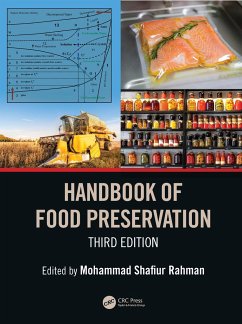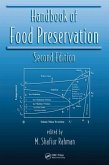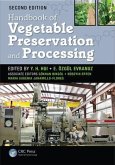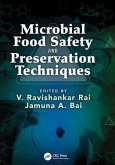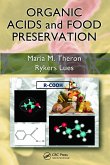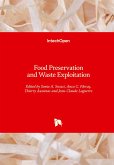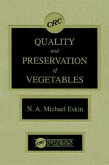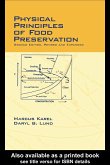Handbook of Food Preservation
Herausgeber: Rahman, M. Shafiur
Handbook of Food Preservation
Herausgeber: Rahman, M. Shafiur
- Gebundenes Buch
- Merkliste
- Auf die Merkliste
- Bewerten Bewerten
- Teilen
- Produkt teilen
- Produkterinnerung
- Produkterinnerung
The ever-increasing number of food products and preservation techniques creates a great demand for an up to date handbook that will facilitate understanding of the methods, technology, and science involved in the manipulation of these conventional and sophisticated preservation methods. Extensively revised, reorganized, and expanded from 43 to 66 chapters, the Handbook of Food Preservation, Third Edition, remains the definitive resource on food preservation. An entirely new section is devoted to issues related to and that impact food preservation, including biotechnology, food security and sustainability, food labeling and food laws and regulations.…mehr
Andere Kunden interessierten sich auch für
![Handbook of Food Preservation Handbook of Food Preservation]() M. Shafiur Rahman (ed.)Handbook of Food Preservation307,99 €
M. Shafiur Rahman (ed.)Handbook of Food Preservation307,99 €![Handbook of Vegetable Preservation and Processing Handbook of Vegetable Preservation and Processing]() Handbook of Vegetable Preservation and Processing384,99 €
Handbook of Vegetable Preservation and Processing384,99 €![Microbial Food Safety and Preservation Techniques Microbial Food Safety and Preservation Techniques]() Microbial Food Safety and Preservation Techniques139,99 €
Microbial Food Safety and Preservation Techniques139,99 €![Organic Acids and Food Preservation Organic Acids and Food Preservation]() Maria M. TheronOrganic Acids and Food Preservation332,99 €
Maria M. TheronOrganic Acids and Food Preservation332,99 €![Food Preservation and Waste Exploitation Food Preservation and Waste Exploitation]() Food Preservation and Waste Exploitation91,99 €
Food Preservation and Waste Exploitation91,99 €![Quality and Preservation of Vegetables Quality and Preservation of Vegetables]() Michael EskinQuality and Preservation of Vegetables547,99 €
Michael EskinQuality and Preservation of Vegetables547,99 €![Physical Principles of Food Preservation Physical Principles of Food Preservation]() Marcus KarelPhysical Principles of Food Preservation414,99 €
Marcus KarelPhysical Principles of Food Preservation414,99 €-
-
-
The ever-increasing number of food products and preservation techniques creates a great demand for an up to date handbook that will facilitate understanding of the methods, technology, and science involved in the manipulation of these conventional and sophisticated preservation methods. Extensively revised, reorganized, and expanded from 43 to 66 chapters, the Handbook of Food Preservation, Third Edition, remains the definitive resource on food preservation. An entirely new section is devoted to issues related to and that impact food preservation, including biotechnology, food security and sustainability, food labeling and food laws and regulations.
Hinweis: Dieser Artikel kann nur an eine deutsche Lieferadresse ausgeliefert werden.
Hinweis: Dieser Artikel kann nur an eine deutsche Lieferadresse ausgeliefert werden.
Produktdetails
- Produktdetails
- Verlag: CRC Press
- 3. Auflage
- Seitenzahl: 1104
- Erscheinungstermin: 6. Juli 2020
- Englisch
- Abmessung: 286mm x 221mm x 63mm
- Gewicht: 2971g
- ISBN-13: 9781498740487
- ISBN-10: 1498740480
- Artikelnr.: 59909139
- Herstellerkennzeichnung
- Books on Demand GmbH
- In de Tarpen 42
- 22848 Norderstedt
- info@bod.de
- 040 53433511
- Verlag: CRC Press
- 3. Auflage
- Seitenzahl: 1104
- Erscheinungstermin: 6. Juli 2020
- Englisch
- Abmessung: 286mm x 221mm x 63mm
- Gewicht: 2971g
- ISBN-13: 9781498740487
- ISBN-10: 1498740480
- Artikelnr.: 59909139
- Herstellerkennzeichnung
- Books on Demand GmbH
- In de Tarpen 42
- 22848 Norderstedt
- info@bod.de
- 040 53433511
Mohammad Shafiur Rahman is an associate professor at the Sultan Qaboos University, Sultanate of Oman. He has authored or coauthored more than 200 technical articles including 81 refereed journal papers, 71 conference papers, 40 book chapters, 33 reports, 8 popular articles, and 4 books. He was invited to serve as one of the associate editors for the Handbook of Food Science, Engineering and Technology, and he is one of the editors for the Handbook of Food and Bioprocess Modeling Techniques, also published by CRC Press. Dr. Rahman has initiated the International Journal of Food Properties (Marcel Dekker, Inc.) and has served as its founding editor for more than 10 years. He is a member of the Food Engineering Series editorial board of Springer Science, New York.
Preface. Introduction: Historical Progress in Food Preservation. Part I:
Preservation of Fresh Food Products. Food Preservation: an Overview.
Cleaning, Washing and Disinfection. Cutting, Slicing and Dicing.
Postharvest Physiology of Fruits and Vegetables. Postharvest Handling and
Treatments of Fruits and Vegetables. Post-Harvest Handling of Grains and
Pulses. Postharvest Handling and Preservation of Fish and Seafood.
Postharvest Handing of Red Meat. Postharvest Handling of Chicken Meat.
Postharvest Handling of Milk. Postharvest Handling of Eggs. Part II:
Preservation of Minimally Processed Foods. Minimal Processing of Fruits and
Vegetables. Ready-to-Eat Meals. Part-Baking Food Products. Combined Methods
for Food Preservation. Update on Hurdle Technology for Mild and Effective
Preservation of Foods. Progress in Developing Guidelines of Food
Preservation for Food Authorities. Part III: Preservation Using Chemicals
and Microbes. Fermentation as a Method for Food Preservation. Natural
Antimicrobials for Food Preservation. Antioxidants in Food Preservation. pH
in Food Preservation. Nitrides in Food Preservation. Salts, Organic Acids,
Phosphates and Sulfites in Food Preservations. Part IV: Preservation by
Controlling Water, Structure, and Atmosphere. Modified-Atmosphere Packaging
of Produce. Glass Transition and State Diagram of Foods. Food Preservation
and Processing using Membranes. Stickiness and Caking in Food Preservation.
Drying and Food Preservation. Smoking and Food Preservation. Osmotic
Dehydration of Foods. Water Activity and Food Preservation. Surface
Treatments and Edible Coating in Food Preservation. Encapsulation and
Controlled Release of Food Ingredients and Bioactives. Part V: Preservation
Using Heat and Energy. Pasteurization and Food Preservation. Canning and
Sterilization of Foods. Cooking and Frying of Foods. Extrusion Cooking of
Foods. Food Preservation by Freezing. Thermal Concentration and
Evaporation. Freezing-Melting (FM) Process in Food Concentration. Microwave
Pasteurization and Sterilization of Foods. Ultrasound in Food Processing
and Preservation. Food Preservation Aspects of Ohmic Heating. UV Light in
Food Preservation. High Intensity Pulsed Light in Food Preservation.
Irradiation Preservation of Foods. Pulsed Electric Field in Food
Preservation. High Pressure Treatment in Food Preservation. Applications of
Magnetic Field in Food Preservation. Preservation of Nutritional Value of
Processed Foods. Part VI: Enhancing Food Preservation by Indirect Approach.
Packaging as a Preservation Technique. Types of Packaging Materials Used
for Foods. Food Packaging Interaction. Intelligent Food Packaging. Hygienic
Design and Sanitation. Hazard Analysis and Critical Control Point (HACCP).
Good Manufacturing Practice (GMP). Commercial Considerations: Managing
Profit and Quality. Part VII: Issues and Technologies Related to Food
Preservation. Biotechnology in Foods. Food Security and Sustainability.
Concerns of Pesticides in Foods. Food Traceability. Waste Management and
Utilization. Food Labeling. Food Laws, Regulations and Standards.
Preservation of Fresh Food Products. Food Preservation: an Overview.
Cleaning, Washing and Disinfection. Cutting, Slicing and Dicing.
Postharvest Physiology of Fruits and Vegetables. Postharvest Handling and
Treatments of Fruits and Vegetables. Post-Harvest Handling of Grains and
Pulses. Postharvest Handling and Preservation of Fish and Seafood.
Postharvest Handing of Red Meat. Postharvest Handling of Chicken Meat.
Postharvest Handling of Milk. Postharvest Handling of Eggs. Part II:
Preservation of Minimally Processed Foods. Minimal Processing of Fruits and
Vegetables. Ready-to-Eat Meals. Part-Baking Food Products. Combined Methods
for Food Preservation. Update on Hurdle Technology for Mild and Effective
Preservation of Foods. Progress in Developing Guidelines of Food
Preservation for Food Authorities. Part III: Preservation Using Chemicals
and Microbes. Fermentation as a Method for Food Preservation. Natural
Antimicrobials for Food Preservation. Antioxidants in Food Preservation. pH
in Food Preservation. Nitrides in Food Preservation. Salts, Organic Acids,
Phosphates and Sulfites in Food Preservations. Part IV: Preservation by
Controlling Water, Structure, and Atmosphere. Modified-Atmosphere Packaging
of Produce. Glass Transition and State Diagram of Foods. Food Preservation
and Processing using Membranes. Stickiness and Caking in Food Preservation.
Drying and Food Preservation. Smoking and Food Preservation. Osmotic
Dehydration of Foods. Water Activity and Food Preservation. Surface
Treatments and Edible Coating in Food Preservation. Encapsulation and
Controlled Release of Food Ingredients and Bioactives. Part V: Preservation
Using Heat and Energy. Pasteurization and Food Preservation. Canning and
Sterilization of Foods. Cooking and Frying of Foods. Extrusion Cooking of
Foods. Food Preservation by Freezing. Thermal Concentration and
Evaporation. Freezing-Melting (FM) Process in Food Concentration. Microwave
Pasteurization and Sterilization of Foods. Ultrasound in Food Processing
and Preservation. Food Preservation Aspects of Ohmic Heating. UV Light in
Food Preservation. High Intensity Pulsed Light in Food Preservation.
Irradiation Preservation of Foods. Pulsed Electric Field in Food
Preservation. High Pressure Treatment in Food Preservation. Applications of
Magnetic Field in Food Preservation. Preservation of Nutritional Value of
Processed Foods. Part VI: Enhancing Food Preservation by Indirect Approach.
Packaging as a Preservation Technique. Types of Packaging Materials Used
for Foods. Food Packaging Interaction. Intelligent Food Packaging. Hygienic
Design and Sanitation. Hazard Analysis and Critical Control Point (HACCP).
Good Manufacturing Practice (GMP). Commercial Considerations: Managing
Profit and Quality. Part VII: Issues and Technologies Related to Food
Preservation. Biotechnology in Foods. Food Security and Sustainability.
Concerns of Pesticides in Foods. Food Traceability. Waste Management and
Utilization. Food Labeling. Food Laws, Regulations and Standards.
Preface. Introduction: Historical Progress in Food Preservation. Part I:
Preservation of Fresh Food Products. Food Preservation: an Overview.
Cleaning, Washing and Disinfection. Cutting, Slicing and Dicing.
Postharvest Physiology of Fruits and Vegetables. Postharvest Handling and
Treatments of Fruits and Vegetables. Post-Harvest Handling of Grains and
Pulses. Postharvest Handling and Preservation of Fish and Seafood.
Postharvest Handing of Red Meat. Postharvest Handling of Chicken Meat.
Postharvest Handling of Milk. Postharvest Handling of Eggs. Part II:
Preservation of Minimally Processed Foods. Minimal Processing of Fruits and
Vegetables. Ready-to-Eat Meals. Part-Baking Food Products. Combined Methods
for Food Preservation. Update on Hurdle Technology for Mild and Effective
Preservation of Foods. Progress in Developing Guidelines of Food
Preservation for Food Authorities. Part III: Preservation Using Chemicals
and Microbes. Fermentation as a Method for Food Preservation. Natural
Antimicrobials for Food Preservation. Antioxidants in Food Preservation. pH
in Food Preservation. Nitrides in Food Preservation. Salts, Organic Acids,
Phosphates and Sulfites in Food Preservations. Part IV: Preservation by
Controlling Water, Structure, and Atmosphere. Modified-Atmosphere Packaging
of Produce. Glass Transition and State Diagram of Foods. Food Preservation
and Processing using Membranes. Stickiness and Caking in Food Preservation.
Drying and Food Preservation. Smoking and Food Preservation. Osmotic
Dehydration of Foods. Water Activity and Food Preservation. Surface
Treatments and Edible Coating in Food Preservation. Encapsulation and
Controlled Release of Food Ingredients and Bioactives. Part V: Preservation
Using Heat and Energy. Pasteurization and Food Preservation. Canning and
Sterilization of Foods. Cooking and Frying of Foods. Extrusion Cooking of
Foods. Food Preservation by Freezing. Thermal Concentration and
Evaporation. Freezing-Melting (FM) Process in Food Concentration. Microwave
Pasteurization and Sterilization of Foods. Ultrasound in Food Processing
and Preservation. Food Preservation Aspects of Ohmic Heating. UV Light in
Food Preservation. High Intensity Pulsed Light in Food Preservation.
Irradiation Preservation of Foods. Pulsed Electric Field in Food
Preservation. High Pressure Treatment in Food Preservation. Applications of
Magnetic Field in Food Preservation. Preservation of Nutritional Value of
Processed Foods. Part VI: Enhancing Food Preservation by Indirect Approach.
Packaging as a Preservation Technique. Types of Packaging Materials Used
for Foods. Food Packaging Interaction. Intelligent Food Packaging. Hygienic
Design and Sanitation. Hazard Analysis and Critical Control Point (HACCP).
Good Manufacturing Practice (GMP). Commercial Considerations: Managing
Profit and Quality. Part VII: Issues and Technologies Related to Food
Preservation. Biotechnology in Foods. Food Security and Sustainability.
Concerns of Pesticides in Foods. Food Traceability. Waste Management and
Utilization. Food Labeling. Food Laws, Regulations and Standards.
Preservation of Fresh Food Products. Food Preservation: an Overview.
Cleaning, Washing and Disinfection. Cutting, Slicing and Dicing.
Postharvest Physiology of Fruits and Vegetables. Postharvest Handling and
Treatments of Fruits and Vegetables. Post-Harvest Handling of Grains and
Pulses. Postharvest Handling and Preservation of Fish and Seafood.
Postharvest Handing of Red Meat. Postharvest Handling of Chicken Meat.
Postharvest Handling of Milk. Postharvest Handling of Eggs. Part II:
Preservation of Minimally Processed Foods. Minimal Processing of Fruits and
Vegetables. Ready-to-Eat Meals. Part-Baking Food Products. Combined Methods
for Food Preservation. Update on Hurdle Technology for Mild and Effective
Preservation of Foods. Progress in Developing Guidelines of Food
Preservation for Food Authorities. Part III: Preservation Using Chemicals
and Microbes. Fermentation as a Method for Food Preservation. Natural
Antimicrobials for Food Preservation. Antioxidants in Food Preservation. pH
in Food Preservation. Nitrides in Food Preservation. Salts, Organic Acids,
Phosphates and Sulfites in Food Preservations. Part IV: Preservation by
Controlling Water, Structure, and Atmosphere. Modified-Atmosphere Packaging
of Produce. Glass Transition and State Diagram of Foods. Food Preservation
and Processing using Membranes. Stickiness and Caking in Food Preservation.
Drying and Food Preservation. Smoking and Food Preservation. Osmotic
Dehydration of Foods. Water Activity and Food Preservation. Surface
Treatments and Edible Coating in Food Preservation. Encapsulation and
Controlled Release of Food Ingredients and Bioactives. Part V: Preservation
Using Heat and Energy. Pasteurization and Food Preservation. Canning and
Sterilization of Foods. Cooking and Frying of Foods. Extrusion Cooking of
Foods. Food Preservation by Freezing. Thermal Concentration and
Evaporation. Freezing-Melting (FM) Process in Food Concentration. Microwave
Pasteurization and Sterilization of Foods. Ultrasound in Food Processing
and Preservation. Food Preservation Aspects of Ohmic Heating. UV Light in
Food Preservation. High Intensity Pulsed Light in Food Preservation.
Irradiation Preservation of Foods. Pulsed Electric Field in Food
Preservation. High Pressure Treatment in Food Preservation. Applications of
Magnetic Field in Food Preservation. Preservation of Nutritional Value of
Processed Foods. Part VI: Enhancing Food Preservation by Indirect Approach.
Packaging as a Preservation Technique. Types of Packaging Materials Used
for Foods. Food Packaging Interaction. Intelligent Food Packaging. Hygienic
Design and Sanitation. Hazard Analysis and Critical Control Point (HACCP).
Good Manufacturing Practice (GMP). Commercial Considerations: Managing
Profit and Quality. Part VII: Issues and Technologies Related to Food
Preservation. Biotechnology in Foods. Food Security and Sustainability.
Concerns of Pesticides in Foods. Food Traceability. Waste Management and
Utilization. Food Labeling. Food Laws, Regulations and Standards.

